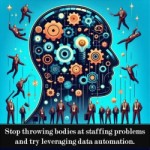
Leveraging Data Automation to Solve Staffing Problems
A REAL-WORLD EXERCISE EXAMPLE – LEVERAGING DATA AUTOMATION TO SOLVE STAFFING PROBLEMS.
Leveraging data automation from a business perspective to solve staffing problems is a very sensitive subject. Especially when it breaches the area of augmenting and replacing employee duties and responsibilities with AI solutions.
Collapsing employee responsibilities across the board onto the emerging data tools and automation, becomes even more frightening to the average employee, manager or even VP.
However, when you leverage data to your advantage, you will save your company time, reduce costs, and increase revenue.
Job Collapsing Exercise from Five Opportunities Staffing Initiative.
To follow is a random example of a Job Collapsing exercise from Five Opportunities Staffing Initiative you will find interesting. The information summary used for this exercise was from website of a random company looking to add headcount.
Summary.
Now, take this information and exercise and extend it to other open jobs across various departments and locations. Then apply the same concept to current internal positions and watch what you uncover. Once you start you won’t be able to stop.
Five Opportunities maintains an extensive library of data strategy resources and content all centered on helping businesses and individuals become more effective at leveraging their data. Job Collapsing is just one of many different methods we use to identify and spotlight these areas.
Contact us to schedule a meeting or your own personalized Job Collapsing discovery exercise and find out how your business can be more data-driven today and far into the future.
